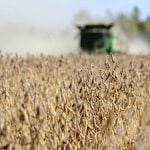This cattle market information is selected from the weekly report from Canfax, a division of the Canadian Cattlemen’s Association. More market information, analysis and statistics are available by becoming a Canfax subscriber by calling 403-275-5110 or at www.canfax.ca.
Fed market stalls
The U.S. fed market broke from its sideways trading range last week and prices are at the highest point since April 2019 so expectations were high for the Canadian fed market last week. However, prices did not keep up with the rising futures market and higher U.S. cash trade. Basis levels weakened, which was not a complete shock because November is one of the weakest basis months of the year.
Read Also

Defence investments could benefit agriculture
A bump in Canada’s NATO spending commitments could lead to infrastructure investments that would benefit rural areas
In Western Canada, bids started last week at $257 per hundredweight delivered and later in the week rose to $261-$262 per cwt. delivered to the plant. Dressed bids and sales ranged from steady to $5 per cwt. higher than the previous week. Sale volumes were too light to establish a weighted average.
On a light market test, the cash to futures basis was estimated at -$5.15 per cwt. On a cash-to-cash basis, Alberta prices were estimated at a $5.40 per cwt. discount against the Nebraska market.
For October, western Canadian fed slaughter averaged 45,911 head per week compared to 44,762 head per week last year. Western Canadian steer carcass weights dropped sharply, averaging 914 pounds. It was the smallest carcass weight since late August.
In Ontario, dressed sales were reported from $269-$270 per cwt. delivered, mostly steady with the previous week. Ontario fed prices usually move to a discount to the western market in fall but that has not been the case this year. Eastern Canadian dressed sales are $8 per cwt. premium against the west.
In nine of the past 10 years, fourth quarter highs have been established in December. Seasonally there is more upside potential for the fed market.
In the U.S., after passing US$128 per cwt. bids in the northern feeding states for three consecutive days, active trade developed Nov. 5 with packers buying cattle at $130 per cwt., which was $4 per cwt. higher than the previous week.
Dressed sales in Iowa and Nebraska ranged from $202-$204 per cwt. Sales in Texas and Kansas were at mostly $128 per cwt.
For the week ending Oct. 23, U.S. beef cow slaughter totalled just over 76,000 head, the largest weekly slaughter since December 2012.U.S. beef exports for September were 21 percent larger than last year. More beef was shipped to China, South Korea and Mexico.
New low for D2 cows
Non-fed prices were mixed last week with slaughter cows slipping $2 per cwt. lower and butcher bull prices firming $1 per cwt. higher. Alberta D2 cows slid to a new annual low, averaging $61.29 per cwt., the lowest weekly average since early 2011.
Compared with Ontario, Alberta D2 cows treaded at a $6.32 per cwt. discount. Alberta D3s last week averaged $52.30 per cwt.
Slaughter cow prices across the western prairies were comparable. Dressed cow bids were sideways, from $120-$125 per cwt. delivered. Bucher bull prices averaged $93.94 per cwt.
Slaughter cow prices are searching for a fourth quarter bottom and should rebound as volumes tighten.
Feeders ease lower
Alberta feeder prices eased lower last week on seasonally ample offerings but peak market volumes are now past. Light calves for the spring grass market saw prices ease around $2.50-$4.50 per cwt. lower than the previous week.
Middle weight calves from 500-700 lb. eased modestly but showed stability on improved risk management opportunities and feeding margins. Large feeders over 700 lb. traded steady to $3 per cwt. lower on varied quality and reduced offerings.
Strong eastern buying interest continued across the Prairies last week. Proximity to Ontario feedlots saw Manitoba 500-600 lb. steer calf prices trading at a $2 per cwt. premium to Alberta last week and 800-900 lb. feeders traded at parity.
Weekly auction volumes in Alberta were 14 percent smaller than the previous week at 82,239 head and were seven percent lower than year ago. Year to date auction volumes were 30 percent larger, totalling 1,400,898 head.
Feeder exports to the U.S. for the week ending Oct. 23 were 19 percent smaller than the previous week at 3,934 head and were 76 percent larger than the same week last year. Year to date feeder exports are up seven percent at 104,117 head.
Calf feeding margins in feedlots are approaching breakeven but feed grain prices are firming higher.
U.S. cutouts rise
In U.S. beef trade, cutout values rose last week with improved demand. Choice averaged US$290.22 and Select averaged $268.22 per cwt. U.S. slaughter numbers were similar to the previous week at about 650,000 head.














